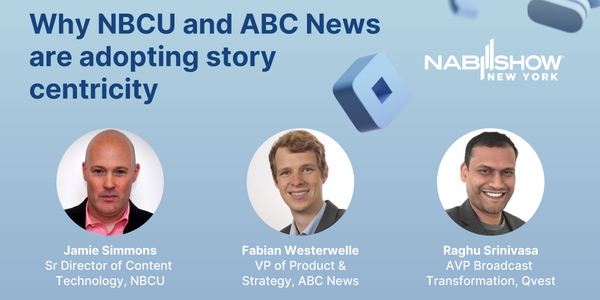
Why AI is Not a Bubble - Especially in Media and Entertainment
GenAI is transforming business operations and expanding creative frontiers
Artificial intelligence (AI) is everywhere and nowhere at the moment. Headlines advertise a brave new world of avatars, automated research assistants and virtual creatives. And yet, Wall Street analysts are concerned about a bubble as profitability remains in question. Despite the skeptics, GenAI’s potential to fundamentally transform the way businesses operate, especially in the media and entertainment industry, is very real.
Artificial intelligence (AI) is everywhere and nowhere at the moment. Headlines advertise a brave new world of avatars, automated research assistants and virtual creatives. And yet, Wall Street analysts are concerned about a bubble as profitability remains in question.
The nascency of GenAI has created a dichotomy between investor expectations for immediate returns on GenAI investment and corporate ambition to advance their leadership position. Chief executive officers with unique competitive advantages from Marc Benioff at Salesforce to Jensen Huang at NVIDIA to C.C. Wei at TSMC are staking claims on GenAI with divergent views.
This fixation on GenAI’s current vs long-term value underscores the need for the intentional use and scalability of the technology now - with an eye toward stronger evolution of its relevant capabilities.
Practical, near-term solutions may not be attention-grabbing, but they solidify the right starting point and validate the value. Despite the skeptics, GenAI’s potential to fundamentally transform the way businesses operate, especially in the media and entertainment (M&E) industry, is very real.
As Q3 earnings season demonstrates, companies including Meta and Apple are increasing their AI spend. Looking ahead, there are bullish expectations for NVIDIA on the heels of surpassing the rare $3.5 trillion market cap milestone - becoming the highest valued company in the world.

GenAI Adoption → Scalability → Predictability
There are, however, still hurdles to consider.
While the chips keep getting faster and the models more complex, software needs to be custom-built for each business. Successful implementation requires a defined process. Already, we’re seeing progress in the development of tools that tailor and integrate these systems into existing tech stacks.
Given Big Tech’s rapidly widening footing in media and entertainment, GenAI success for M&E relies on a sharp focus on adoption, scalability and predictability. Now, entertainment companies need to mobilize to advance beyond proof of concepts and fully implement these game changing systems.
This is one of the major challenges in M&E. High expectations at the enterprise and consumer level can leave M&E decision makers stuck - either they delay innovation and prototypes never make it into production, or worse, inoperable products are rushed to consumers.
It’s only a matter of time, however, before more widespread integration comes to fruition - and then the exponential ROI - and the category leaders - will be abundantly clear.
Early Results Accelerate Enterprise GenAI Innovation
While updated tech infrastructure is underway, deliberate GenAI accelerators that rapidly test deployments are showing positive results. These ROI based projects are the necessary foundation for expeditious and scaled adoption in a more structured business environment.
Currently, M&E executives are hyperfocused on proving the immediate impact of GenAI to pave the way for enterprise-wide adoption. This work, achieved through accelerator programs, prioritizes areas including, but not limited to, IP & rights management, digital media supply chain workflows and advertising sales, with change management cutting across these functions.
For IP rights administration and content licensing, GenAI can efficiently extract contract terms to mitigate risks and maximize opportunities. Similarly, for legal teams, GenAl increases the discoverability of existing contracts with natural language search and enables automated extraction of key deal terms.
The net effect of timely, accurate information is improved quality control and faster decision-making - with the potential of accelerated deal flow.
Optimizing and expanding the use of media assets has been another priority. For example, in newsrooms and during live sports broadcasting, GenAI applied to digital media generates revenue and efficiency gains by speeding up the time-consuming and labor-intensive process of cataloging and annotating digital content like videos and photos.
In some cases, what took weeks now only takes minutes. Media assets can be more quickly repurposed across markets and sectors, expanding licensing, content creation and overall distribution opportunities. And, we have already seen NBCUniversal generate instant clips during live broadcasts like the 2024 Olympics.
And in advertising, a major revenue driver for Big Tech and M&E, AI has significant potential to enhance highly targeted ads and enable premium pricing. Increased consumer interaction, more data and personalization of content will improve user experience and yield returns for both platforms and advertisers.

Leverage GenAI to Future-proof the Media Industry
The M&E C-suite realize that in a fiercely competitive market, increased operational efficiencies and new capabilities will be crucial to future-proof their companies. Big Tech has already committed to GenAI. They must as well.
On a parallel path, scalable GenAI priorities necessitate a change management plan to meet users where they are as they learn to harness this new technology. With an upfront GenAI strategy, the C-suite will create a path to strategic innovation.
As AI players continue to shine in earnings, and corporate investments begin to pay off, we’ll only see more benefits of purposeful adoption - including boosting the bottom line and creating entirely new content. That’s a use case investors, executives and creators are bound to champion.

